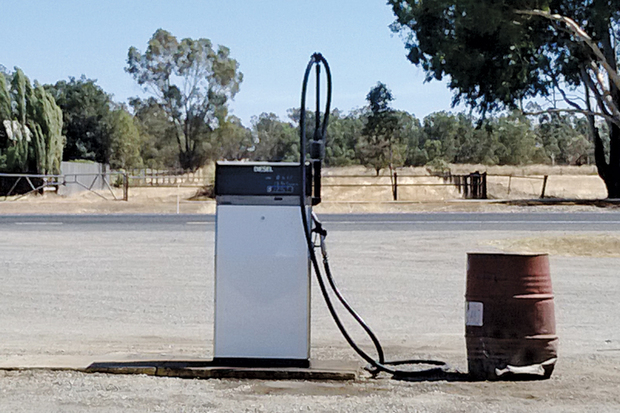How can I recognise dangerous goods?
Most farms use some form of dangerous goods, either to operate machinery (e.g. fuel, oil) or to control weeds or pests (e.g. fumigants). Dangerous goods are substances that have properties that can be dangerous or hazardous to health if not stored and handled safely.
Dangerous goods can be recognised by the marking and labelling, with the presence of a class diamond and a United Nations (UN) number on the packaging. The class diamond indicates which hazard the item has.

What should I do when I receive a delivery?
On receiving a delivery of dangerous goods, check that the packages are in sound condition and are labelled correctly. If the packaging or labelling is defective, contact the supplier to rectify.
What do I need to consider when storing?
Segregate
A number of dangerous goods can react dangerously when mixed and have the potential to start a fire or release toxic gases. Be safe and store these goods apart (Table 1).
| Segregate | ||
|---|---|---|
| pool chlorine (solid calcium hypochlorite) | from |
|
| bleach (liquid hypochlorite solution) | from | acids |
| dangerous goods | from | foodstuffs |
oxygen gas* *Except when use | from |
|
Security is important
Security measures need to be in place to prevent unauthorised access. This is particularly important for highly toxic dangerous goods such as:
- 1080 baits
- aluminium phosphide pesticides
- other herbicides and pesticides.
Protect above ground storage areas from impact
On a farm, there is usually enough space to place dangerous goods storage facilities (e.g. shed) out of harm’s way.
Sometimes this is not practical though, for example if there is a fuel dispenser near an above ground fuel tank.
In these situations, you need to protect the tank and dispenser from vehicle impact. You can do this by installing bollards (concrete-filled steel pipes) or placing clean 200 L or 110 L drums filled with concrete or sand around the area.

Underground fuel tank guidance
Some properties have underground fuel storage tanks. These tanks need to be designed, installed, operated and maintained so that they do not leak. Guidance is available in Australian Standard AS 4897 on how to store fuel in underground tanks safely (see Resources and guidance).
How do I handle dangerous goods safely?
Ignition sources
When handling flammable liquids (e.g. petrol) or flammable gases (e.g. LP or acetylene gas), ignition sources need to be kept away. These sources include naked flames, mobile phones or activities such as smoking, welding, cutting and grinding.
Safety information and equipment
Safety data sheets (SDSs), are good sources of safety and health information for the dangerous goods you have. SDSs are available from the supplier or manufacturer of dangerous goods or can be found on the internet.
You should keep SDSs for all dangerous goods stored and handled at the farm readily accessible in case of spills, poisoning or emergencies,.
These sheets also provide guidance on the types of personal protective equipment (PPE) that should be used when handling. PPE should be kept and maintained ‘fit-for-purpose’.
In particular, check that respirator cartridges are rated to the particular type of chemical being used.
Workers and supervisors
Induction, information, training and supervision need to be provided to those who work with dangerous goods. There should be safe systems of work and work practices that enable people to perform their job safely.
Relevant training needs to be considered for:
- workers who carry out specific tasks, such as handling herbicides
- managers and supervisors who should have training relevant to the dangerous goods in areas they supervise.
This may be provided in-house or alternatively, take the form of in-services by agricultural industry trainers or chemical suppliers. This could include providing SDSs and proper use of PPE and safety equipment.
How can I dispose of dangerous goods safely?
Clean up spills or leaks
Dangerous goods stored on the farm sometimes spill or leak. Make sure that the spill or leak is cleaned up as soon as possible using a spill kit.
Check that you have a spill kit handy. The kit could include a bucket of clean dry sand, ‘kitty litter’, clean empty containers with lids or caps for spill recovery, broom and shovel.
Empty containers
Empty dangerous goods containers, such as plastic drums, need to be made safe through industry recycling initiatives like AgSafe’s drumMUSTER collection, or containers properly disposed of. Re-use of dangerous goods containers should only happen after appropriate decontamination means (e.g. scrubbing, rinsing, steam cleaning) to effectively remove chemical residue.
Unwanted chemicals
Keeping old or unwanted chemicals in your shed presents an unnecessary risk to people, animals and the environment. AgSafe’s ChemClear program is run periodically to assist in the disposal of unwanted chemicals.
Resources and guidance
Australian Standards
The following Australian Standards apply to dangerous goods storage and handling on farms.
- AS 1940 The storage and handling of flammable and combustible liquids
- AS 2507 The storage and handling of agricultural and veterinary chemicals
- AS 4897 The design, installation and operation of underground petroleum storage systems.
Australian Standards are available from Standards Australia.
Other resources
- Safe storage and handling of dangerous goods on farms: Pamphlet
Handy tips on how to store and handle dangerous goods on farms safely. - Dangerous Goods Safety (Storage and Handling of Non-explosives) Regulations 2007: Guide
Practical guidance on how to comply with the regulations. - AgSafe
- Australian Dangerous Goods Code (ADG)

